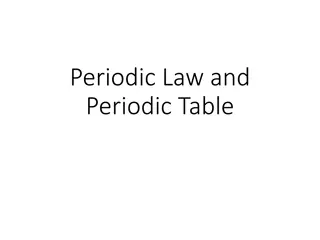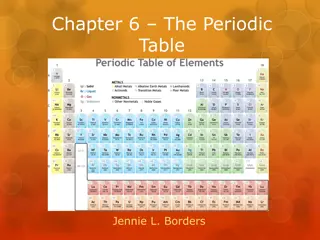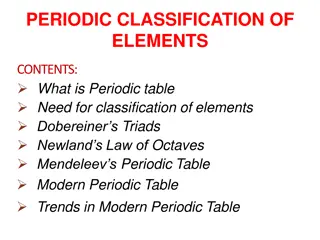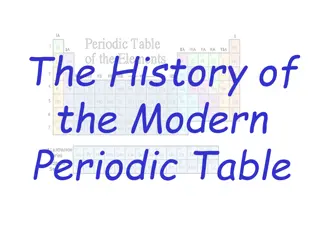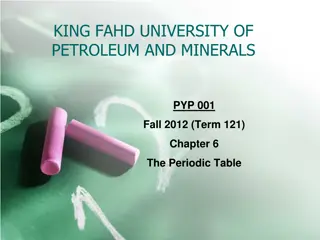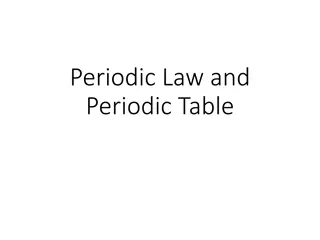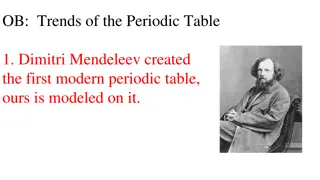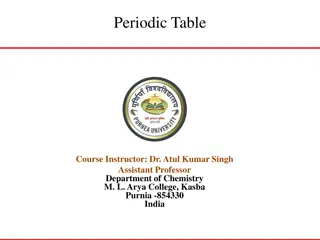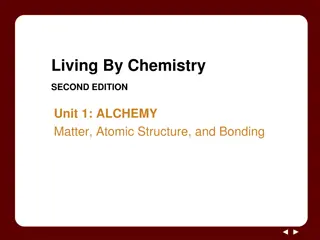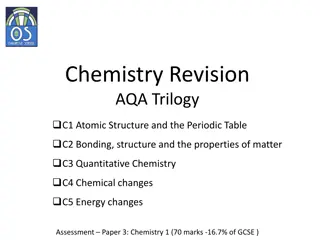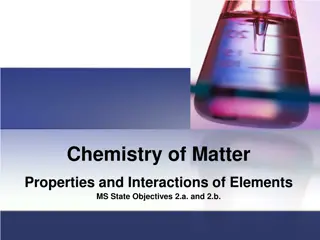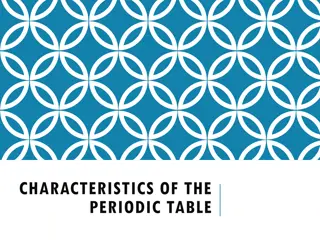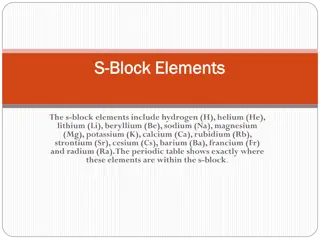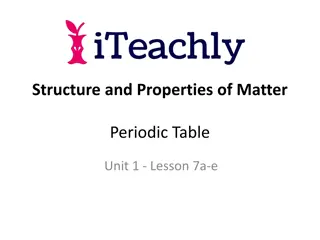
Understanding Periodic Table Trends and Atomic Structure
Explore the evolution of the periodic table from Mendeleev to Moseley, learn about the periodic law, atomic mass, atomic number, and elements' structure and properties. Discover the significance of arranging elements by increasing atomic number for a better understanding of chemistry.
Download Presentation

Please find below an Image/Link to download the presentation.
The content on the website is provided AS IS for your information and personal use only. It may not be sold, licensed, or shared on other websites without obtaining consent from the author. If you encounter any issues during the download, it is possible that the publisher has removed the file from their server.
You are allowed to download the files provided on this website for personal or commercial use, subject to the condition that they are used lawfully. All files are the property of their respective owners.
The content on the website is provided AS IS for your information and personal use only. It may not be sold, licensed, or shared on other websites without obtaining consent from the author.
E N D
Presentation Transcript
MENDELEEV & MOSELEY Dmitri Mendeleev , a Russian chemist, noticed that when the elements were arranged by atomic mass, there was a periodic pattern in properties He left blank spaces open for new elements to be discovered He was one of the first to arrange the elements in an organized table His arrangement had its faults though
When new elements were discovered, it became apparent that they didnt fit into Mendeleevs table properly When arranged by mass, the properties did not correspond Moseley (1913) Arranged periodic table by atomic number Elements close to one another have similar properties
PERIODIC LAW Periodic Law: there is a periodic repetition of chemical and physical properties of the elements when they are arranged by increasing atomic number
HOW TO READ THOSE NUMBERS Atomic Mass: Approx. the mass of the protons in the element 1 atomic mass unit (amu)= mass of 1 Carbon 12 atom Atomic Number: # of protons in the nucleus The atomic number increases by 1 as you go across a row Also the number of electrons in the element if it is neutral
WHAT IS IN AN ELEMENT/ATOM? Protons: Positive Charge (+) Neutrons: No Charge Electrons: Negative Charge (-) Protons +Neutrons make up a nucleus Electrons circle around the nucleus in orbitals In general, #protons=#electrons (neutral) Also #neutrons= atomic mass-atomic number If they differ in neutrons, it is called an isotope C12, C13, C14
SO If elements are ordered in the periodic table by atomic number, then they are also ordered according to the number of electrons they have. The lineup starts with hydrogen, which has one electron. Helium comes next in the first horizontal row because helium has two electrons. Lithium has three.
VALENCE ELECTRONS In an atom there are multiple orbitals (think planets) Valence electrons: electrons in the outer most orbital these determine the chemical properties of the element These are also the bonding electrons (remember, core electrons don t bond)
BACK TO THE PERIODIC TABLE Period: Horizontal Row (think sentence) Numbered from top to bottom Group/Family: Column/Vertical Numbered from left to right
PROXIMITY MATTERS Elements in the same group have characteristics similar to each other, yet different from the other elements in the periodic table. Similarities occur because elements in the same group have the same number of valence electrons
NAMES & ORGANIZATION Periodic table is divided into different groups Think about the different colors we colored
Groups 1A Alkali metals Very reactive Explosive reactions with water One valence electron All metals Groups 2A Alkaline Earth Metals Quite reactive Two valence electrons All metals
Groups 3A Boron Family Varies from semi-metallic to non-metallic in properties Three valence electrons Group 4A Carbon Family Varies from non metallic to metallic in properties Four valence electrons
Group 5A Nitrogen Family Varies from non-metallic to metallic properties Five valence electrons Groups 6A Oxygen Family Mostly non-metallic Six valence electrons Group 7A Halogens All are non-metallic and make colorful gases Seven valence electrons
Group 8A Noble gases All non metals and highly unreactive Eight valence electrons (OCTET) Transition metals All have metallic properties Valence number varies Lanthanoids & Actinoids Radioactive, many are non-natural or man-made Valence number varies
METALLIC CHARACTER Metallic Character Element on the left side of the periodic table are metals, while those on the right side are non metals. Elements that touch the dividing line between metals and nonmetals are called metalloids Metallic character increases as you move down a column and across a row to the left
REACTIVITY Reactivity Reactivity for metallic element increases as you move down a column and across a row to the left The most reactive metal is Francium (bottom, left corner) Reactivity for nonmetal increases as you move up a column and across a row to the right The most reactive nonmetal is Fluorine (top, right corner) WE DO NOT EVEN LOOK AT NOB GASES!!!
IONIZATION ENERGY Ionization Energy 1. The energy needed to remove the outermost electron from an element (increases dramatically with successive removals) 2. Ionization energy depends on the number of valence electrons and the size of the atom Elements with nearly full valence shells will have higher ionization energy than those with nearly empty valence shells Larger elements will have a lower ionization energy than smaller elements
Ionization energy increases as you move up a column and across a row to the right.
ELECTRONEGATIVITY/ELECTRON AFFINITY Electronegativity (similar trend to ionization) Ability of an element to attract shared electrons to itself Depends on the number of valence electrons and the size of the element Increases as you move up a column and across a row to the right
ATOMIC RADIUS Atomic Radius Close approximation of the relative size of an atom Determined by finding the distance from the center of an atom nucleus to it s outermost electron Increases as you move down a column Each step down in a column increases the number of orbitals (electron shells) Increases as you move across a row to the left Decreasing the number of protons in the nucleus causes the electrons to be held more loosely
HOW SIZE CHANGES Ionic Size Size of an atom when electrons are added or removed Electrons removed atom become smaller (Cations + charges) Electrons added atoms become larger (Anions charges)
WHY THESE TRENDS? Effective Core Charge (increases by 1 as you go right across periodic table) Electron shielding (the more electrons, the more repulsion from each of those electrons)

